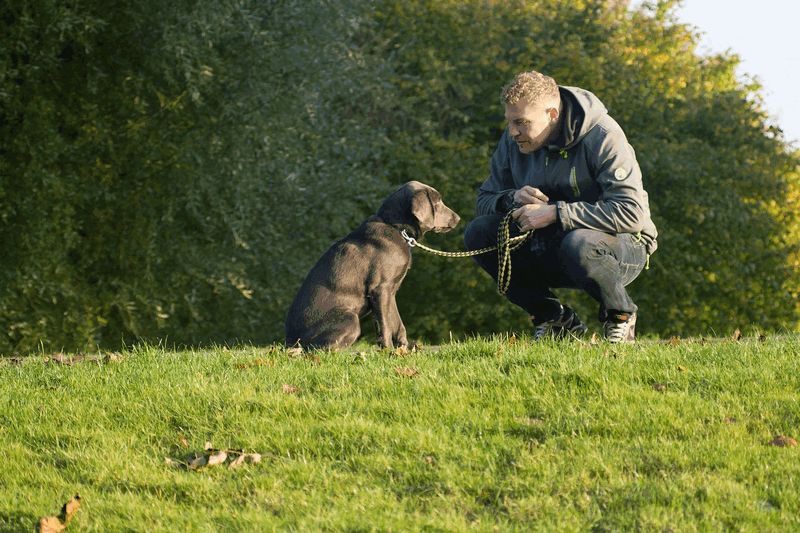The Importance of Consistency in Dog Training

Do you feel that your dog just seems to be on the wrong page sometimes? They’re in the household, and they’re a part of your family, but they just don’t get it? Maybe this disconnect is even associated with relationships, Say that your dog is great with one family member but not the other. Maybe your precious puppy jumps all over your uncle but not your aunt? Regardless, it’s frustrating, and also fixable.
Dogs want to know what they should be doing. They are members of a pack and they’re looking at you as the leader for guidance. But you can’t do it alone. The best training, no matter who performs the initial teaching, is only as successful as everyone else involved. It takes a village isn’t just a saying,
Training is crucial for many dogs and their families. However, what’s possibly even more crucial is that consistency is achieved across the board. Dogs are not born as multi-lingual, and English has to be learned. Everything from language to participation may be holding your furry friend back from being the best he could be.
But why is consistency important? How important is it? Continue reading below for those answers and more.
Why Consistency is Crucial for Dog Training
Dogs of all breeds and ages tend to thrive when a bit of a routine is established. Even in the wild, canines tend to follow predictable patterns. Consistency is important because it helps to reinforce those patterns and works to dispel any confusion your dog may have. This is true for consistently attending a training course, or even for ensuring that everyone your dog lives with is consistent with the language and tools used during the dog’s training.
Predictability and Success
When someone with a dog, whether young or old, consistently uses the same commands, gestures, and routines, the dog then learns to anticipate what will happen next. This is true for verbal cues such as “sit”, or even hand signals, and more. Inconsistent cues or reactions make it harder for your dog to grasp what behavior is being rewarded or corrected/extinguished.
Without predictability, your dog may struggle to follow the patterns and put the puzzle together. When every person who is in your dog’s life uses different language and cues, your dog will continue guessing what they should be doing or how they should be acting.
Building Strong Habits Through Reinforcement
Repetition is the heart of forming habits, and this is true for both dogs and humans too. By consistently reinforcing good behavior, you create a clear learning pathway. You may also find that consistently having your dog attend their courses, such as those provided by Next Step K9, also helps your dog learn by forming pathways and ensuring that nothing important is missed.
Reinforcement creates neural pathways and helps your dog learn. When you bring your dog to class, you will allow your dog to learn what they need to. However, if you’re inconsistent with attendance, and inconsistent with following class guidelines such as language used and methods used, your dog will struggle to learn what it needs to.
The Importance of Timing
Consistency isn’t just about what, but when. Timing plays a critical role in training your dog. The quicker the behavior is reinforced or discouraged, the sooner, and stronger the association will be made.
Strength in Immediate Feedback
When in training, a skilled trainer knows to follow appropriate timelines and cues. For most dogs, it’s important to aim to provide feedback within 1-2 seconds of the dog’s behavior. If too long is waited, then the dog may not link the action with the consequence, whether good or bad.
Inconsistency and Behavioral Issues

Inconsistent training doesn’t just slow down the learning process, but it can also cause confusion and lead to behavioral problems such as aggression. When dogs receive a combination of mixed messages, they can easily become anxious, defiant, or suffer other issues.
Confusion and Anxiety
When a dog is unsure when they’ll be rewarded or corrected, they may become uncertain about their next step. This causes anxiety, restlessness, or destructive behavioral issues.
Reinforcing Behavior
Inconsistent training can accidentally reinforce unwanted behaviors. When you maintain consistency across the board, you avoid these possible pitfalls.
Following a Consistent Training Schedule
Maintaining consistency in your dog’s training can be easier than you thought. Next Step K9 makes training easy, as we plan and execute the perfect schedule for your dog, from methods to timing, to the actual training, we’ve got you covered.
An important aspect of creating a winning training plan is to create clear commands and rules. Setting your expectations is important but so is giving your dog the tools to follow them. It’s important that everyone in the home, and the trainer themselves, uses the same verbal cues, hand signals, and routines every time. For example, if during training the term “down” for lie down is established, it’s important to use that consistently. Do not switch to ‘lay’ or “lie down”, as changing the verbiage will confuse your dog and set back their success.
Consistency extends to house rules. Make sure that everyone in the home knows and enforces the rules set forth.
Training Sessions
Training sessions should be regular as dogs, especially puppies, learn best with frequent sessions. Regular practice helps keep the dog’s skills sharp and relevant. It will also help them from falling back into old habits. Refresher sessions, such as our group sessions, are a great way to help give your dog that reminder they may need every now and then.
Be sure that training starts as early as possible and that all rules, cues, and language are followed universally even after the training sessions end.
Closing Words
When it comes to successful dog training, whether using positive reinforcement training, balanced training, or something else, consistency is key. Consistency is important for dog training because it helps form the pathways and routines required for your dog to learn and follow what they’ve learned once the training sessions stop.
Consistency helps form the foundation of effective training, helping your dog understand the expected and reinforce behavior. Whether learning basic dog obedience, or working on complex dog behavior, consistency is crucial to success.
When consistent training is maintained, including consistent commands, rewards, and techniques, you’ll see results that last a lifetime. Consistency is the key to unlocking the well-behaved and confident companion your dog could be.
Next Step K9 is here to help consistently train any dog, whether young or old. Contact us today to learn more about our services and how we can help.
